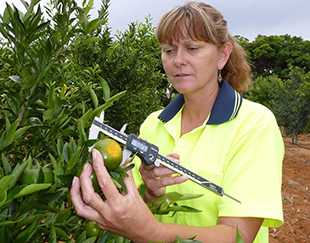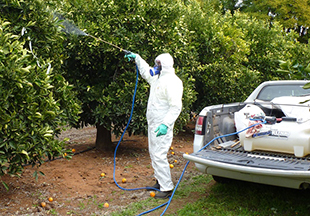
Sunraysia on-farm research results available

A Horticulture Innovation Australia (Hort Australia) project (CT10030) to extend citrus production practices that increase the yield of marketable fruit and to identify non-profitable practices was conducted from September 2010 to September 2013. NSW DPI and the Murray Valley Citrus Board co-funded the project.
Twenty-two replicated citrus (mainly navel orange) demonstration trials were established on grower’s properties.
Products and practices trialled included potassium (ground and foliar applied), Dichlorprop-P fruit-sizing spray (Corasil®), winter gibberellic acid GA (Ralex®), hand thinning, hand pruning, summer urea fruit-sizing spray, GA flower fruit-setting spray, young tree growth bio-stimulant enhancing sprays, kaolin clay foliar sprays and wind blemish assessment.
Following is a summary of the project results. A full copy of the report is available from the Horticulture Innovation Australia (HIA) website. The report is available for free to Australian horticulture levy payers (i.e. citrus growers), registered members and industry representative bodies. You just have to fill in an online form to join up and then you get access to this and any other HIA report.
Project results summary

Foliar potassium was trialled on 4 sites and ground application on 2 sites. An approximate 2 mm increase in fruit size was detected only on one site that had no previous history of potassium application for over 10 years.
Using foliar potassium sprays is questionable if the fruit size is large and/or an annual maintenance program of approximately 50 kg/ha of potassium is applied.
The block that demonstrated the response had leaf potassium levels at approximately 1%, whilst blocks providing no responses were at 1.2–1.4%
No fruit size increase was detected for summer urea. Large fruit size throughout the whole block occurred when it was trialled and it is suspected that this masked possible differences. Trials need to be repeated in blocks with district-average fruit size.
Using products and practices that enhance fruit size is questionable in a low-cropping year when fruit size will be large and/or in blocks that naturally produce large fruit. Enhancing fruit size of large fruit might increase rind coarseness that can downgrade fruit quality and prices. Pictured at top is Karen Connolly (former NSW DPI Project Officer) measuring trial fruit.
Kaolin clay products Surround® and Screen® significantly reduced the incidence of fruit sunburn. The trial lasted for two years and Surround® provided significant results in both years, whilst Screen® for only one year. Surround® had significantly higher levels of sooty mould on fruit caused by an increase in red scale and mealybug infestation of fruit and canopy.
Tree growth bio-stimulants Brotomax® and Branch-It® did not increase growth in young navel or Imperial mandarin trees. Navel trees used in the trial could have been water-stressed during their establishment phase and this might have affected results. Steve Falivene, project leader (pictured) is applying treatments to a trial.
Soil conditioning products did not provide a response. Organic matter can take time to break down and affect soil biological and physical properties. Possible beneficial effects might occur after several years.

